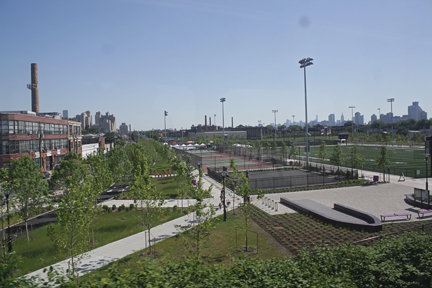A stroll around Berry Lane Park is more than just exercise; it’s a trip through time.
Founders of the city’s largest park don’t want people to forget what stood on the site prior to the park’s opening in June 2016.
For many, like resident and community activist Lavern Washington, it’s hard to forget the massive gray buildings that marked the Garfield Avenue side of the park.
Passing through the Bergen-Lafayette neighborhood in this part of the city was like moving through a tunnel with industry on either side.
For years, folks dreamed about a light at the end of this tunnel that would brighten one of the most contaminated sites in the city.
Residents in Ward F on one side of the property and those from the historic Morris Canal section on the other often met in kitchens or living rooms, with city officials and environmentalists, hoping that if they talked enough about their dream it might someday come true.
Remarkably, it did.
Walking the Talk
“I can’t believe it really happened,” Washington says. Fortunately, community activists had key allies in government, such as Betty Kerns, who helped keep the vision alive, finding pockets of money at critical times.
Cobbled together from more than 11 parcels of land, the property was once home to a variety of industries dating back to the beginning of the 20th century when the Greenville section was a national railroad hub. A chromium plant operated 24 hours a day on the Garfield side from about 1924, refining raw chromium ore into paint pigment and other products. Pittsburgh Paint and Glass (PGG) bought the facility in 1954 and closed it in the fall of 1963. In the years that followed, the property became home to other industrial facilities, auto repair shops, junkyards, and warehouses. For more than a decade, it was a hangout for street gangs and a canvas for graffiti artists.
In the mid-1990s, Washington and others began to seriously lobby for the city to do something.
Eventually the Jersey City Redevelopment Authority acquired parcels from PPG, some by eminent domain. In 2009, the Environmental Protection Agency came to an agreement with PPG for a cleanup that included removing chromium-tainted soil. PPG agreed to pay about $5.5 million toward the cleanup costs.
If You Build It…
Construction on the park began in 2012. Grading, demolition, and drainage, sidewalk, and lighting installation were completed in 2013 and 2014. In October 2014, the City of Jersey City was awarded a $5 million grant from the New Jersey Economic Development Authority (EDA), allowing the final phase to be completed ahead of schedule. The EPA also provided federal funds to transform an eyesore into an oasis.
When fully operational Berry Lane will mirror Pershing Field, providing many of the same amenities to residents in the southern portion of the city that are currently available to residents of the Jersey City Heights.
The 17.5-acre, $40-million park features large recreation areas, including two basketball courts, two tennis courts, a baseball field, soccer field, splash-pad water park, playground, and skate park, in a neighborhood where more than 60 percent of residents are under 18.
Other features include rain garden, bike paths, more than 600 new trees, and two historic plazas incorporating elements of the original industrial architecture. From dawn to dusk, the park is already occupied; for many, a walk around the perimeter has become a ritual. Although still largely devoid of shade, this will change when those 600 trees start to grow.
Down Memory Lane
Park designers retained some elements of the past, including concrete silos and remnants of the former rail yard, which will be refitted as a spray park.
Marvel Architects designed the modest concessions pavilion at the center of the park to embody and celebrate the historic Morris Canal Greenway, which runs through Berry Lane. The structure is inspired by the materials that were moved along the canal: coal and iron ore. The pavilion also houses restrooms, changing rooms, administration offices, and exterior shaded space.
Just as Grove Street got its name from the peach groves that flourished in a rural Jersey City, the park got its name from the berry patches growing on a two-block street running south off Communipaw, east of Garfield, according to Councilman Richard Boggiano. Today, Berry Lane echoes the most industrial parts of Jersey City. Walk down it any time over the past half century, and the last thing you would think to find there is a park. What you do see are rusted machinery and crumbling factories straight out of the industrial age, when people didn’t think about pollution or the environmental impact of such facilities on the community and the planet. On the border of the poorest section of Jersey City—dotted with Garfield Avenue’s auto-repair shops—the city’s newest and largest park is the jewel in a rusted crown.
Jersey City Mayor Steven Fulop and Ward F Councilwoman Diane Coleman believe the park is the first ripple in a tide that will lift the neighborhood to new heights.—JCM
